上海牛津小学英语语法知识总结精选文档
语法知识点汇总(知识清单)牛津上海版(试用本)英语六年级下册

六年级语法知识点人称代词表格名词性物主代词=形容词性物主代词 +名词现在进行时1.现在进行时表示说话时正在进行或发生的动作。
例如:I am reading a book. 我正在看书。
2.表示现阶段正在进行而说话时不一定在进行的动作。
例如:I am learning English hard these days.这些日子我正在努力学习英语。
II. 现在进行时的标志词。
现在进行时常和now、at the moment、look、listen. Where is somebody? It’s+时间 等连用。
现在进行时的基本结构肯定式:am/is/are+doing(现在分词)They’re having a meeting now. 他们现在正在开会。
否定式:am/is/are not +doing(现在分词)They aren\'t having a meeting now. 他们现在没有在开会。
一般疑问式:Am/Is/Are + 主语 +doing(现在分词)+ 其他Are they having a meeting now? 他们现在正在开会吗?特殊疑问式:特殊疑问词+一般疑问式What are they doing now? 他们现在正在做什么?现在分词(doing)的变化规则1. 一般情况下,在动词词尾加ing。
go——goingplay——playingknow——knowing2. 以不发音的字母e结尾动词,先去e再加ing。
make——makingarrive——arrivinge——ing3. 以重读闭音节结尾,且动词词尾只有一个辅音字母时,先双写这个辅音字母,再加ing。
run——runningstop——stoppingswim——swimmingrun——runningput——puttingsit——sittingbegin——beginningplan——planningcut——cuttingget——gettingshop——shoppingchat——chattingregret——regrettingdig——digging4. 以ie结尾,先将ie改成y,再加ing。
牛津上海版英语六年级下学期知识点总结

牛津上海版英语六年级下学期知识点总结
本文档总结了牛津上海版英语六年级下学期的知识点,供学生复和回顾使用。
一、Grammar(语法)
1. 过去式
- 动词过去式的构成规则
- 一般过去时的用法和表示方式
2. 定语从句
- 定语从句的构成
- 定语从句在句子中的作用和使用
3. 情态动词
- 情态动词can、could、may、might、must的用法和意义
- 情态动词表示能力、可能性、推测、必须性等的表达方式
二、Vocabulary(词汇)
1. 动词短语
- 动词短语的构成和用法
- 常用的动词短语及其意义
2. 名词短语
- 名词短语的构成和用法
- 常用的名词短语及其意义
3. 形容词和副词
- 形容词和副词的构成和用法
- 常用的形容词和副词及其意义
三、Reading(阅读)
1. 阅读理解
- 阅读理解题的解题技巧和策略- 阅读理解题型的种类和难度分布
2. 短文阅读
- 熟悉短文阅读中常见的词汇和句子结构
- 提高对短文主旨和细节的理解能力
四、Writing(写作)
1. 书信写作
- 书信写作的格式和语言表达
-如何正确使用称呼和结束语
2. 日记写作
- 日记写作的格式和内容要求
- 如何描述事件和个人感受
以上是牛津上海版英语六年级下学期的知识点总结。
希望同学们能够仔细复,并在考试中取得好成绩!。
上海牛津版小学英语语法
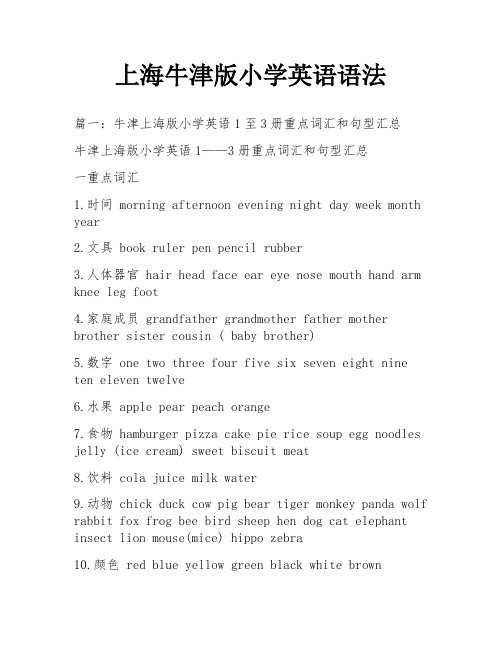
上海牛津版小学英语语法篇一:牛津上海版小学英语1至3册重点词汇和句型汇总牛津上海版小学英语1——3册重点词汇和句型汇总一重点词汇1.时间 morning afternoon evening night day week month year2.文具 book ruler pen pencil rubber3.人体器官 hair head face ear eye nose mouth hand arm knee leg foot4.家庭成员 grandfather grandmother father mother brother sister cousin ( baby brother)5.数字 one two three four five six seven eight nine ten eleven twelve6.水果 apple pear peach orange7.食物 hamburger pizza cake pie rice soup egg noodles jelly (ice cream) sweet biscuit meat8.饮料 cola juice milk water9.动物 chick duck cow pig bear tiger monkey panda wolf rabbit fox frog bee bird sheep hen dog cat elephant insect lion mouse(mice) hippo zebra10.颜色 red blue yellow green black white brown11.天气 sunny cloudy rainy windy warm hot cool cold12.季节 spring summer autumn(fall) winter13.服装 T-shirt dress shorts blouse shirt14.动词 dance read sing draw give thank see look do love eat drink help cut stick colour fly go hearlisten taste smell touch stand sitlike go e play wantride skip fold write help run jump pick swim put use wonder twinkle hop take fall close climb crytell15.形容词 fine fat thin tall short nice little round juicy sweet high yummy super happymerry new old young good bad poor big small dear ready bright smooth soft cute naughty sorry beautiful16.人称代词 I(me) you(you) she(her) he(him) it(it)we(us) you(you) they(them)17.物主代词 my your his her its our your their18.介词in on under for to with at like19.其它 house flower can who is are howstory bye goodbye hello please this thatthese those theand no not what classmate schoolschoolmate friend paper many (how many) here may have has had was there(there is) (there are) park zoo up down very name kite birthday song weather again away another beach rain bicyclegiftrope card firecracker firework all narrator farmer where boy girl man woman ballnoon treedollslide swing ball Miss Mrs Mr bag stick supergirlsuperboy superman but can’t don’t isn’t aren’twhat gate plate fork knifechopsticks bowl spoon jar seesaw colour game net box desk chair tablegueen sun moon star sky diamond grass animal food umbrella van window tree or lie age二重点句型1. Hello! Goodbye! Good morning ! Good afternoon!2.I’m Liu Yian.3. Give me a ruler,please ! Here you are ! Thank you !4. How nice !5. This is my ear !6. Alice, touch your eye !7. What can you do ? I can draw !8. Who is she ? She’s my mother!9. This is my father ! This is Kitty. She’s my friend. She’s thin. 10. How many books? Two books.11. Pears,please! How many pears? Three pears. I love to eat! 12. Can I help you? May I have a pie, please? Here you are ! Thank you! 13. What’s this? It’s a chick. What’s that? It’s a cow. 14. Is that a monkey? Yes. Is this a bear ? No, it’s a panda. 15. There’sa lion in the zoo ! What colour is it ? It’s brown.16.Colour the rubber green . 17. What do you see ? I see a panda. What do you hear ? I hear a pig. 18.Taste the noodles,Tom. Yummy,Yummy. Smell the soup, please. It’s nice. 19.Can I help you ? Soup, please . Here you are . Thank you. (Thank you very much. ) 20. Stand up ! Sit down ! 21. I like the ball. I like kites. 22. Do you like sweets ? No. Do you like jelly? Yes, I like jelly! 23. One for you and one for me!24.Drink some water, Mum. Thank you. 26. You are a good girl. 27. What do you like ? I like milk. 28. Happy birthday ,Liu Yian. Thank you! Let’s sing a birthday song. 29. Spring is warm. Summer is hot. Autumn is cool. Winter is cold. 30. In summer,it’s hot. I drink some juice.31. How is the weather? It’s sunny. Let’s go to the beach.32. What do you need ? I need a new dress. I don’t like brown, Mum. I like red. 33. Skip myrope ,my friend. 34. A gift for you! Happy newyear !35. Where’s the wolf ? 36. Here es the wolf . 37. Don’t tell a lie. You’re a bad boy. 38. Howare you , Liu Yian. I’m fine , thank you. 39. I’m Liu Yian. I’m a boy. I’m short and thin.40. Who am I ?41. I’m big. You’re small. Is it a cat ? Yes , it’s a cat. Is it a dog ? No, it isn’t. 42. Are you a boy? Yes. Are you seven ? No, I’m nine. 43. Can you draw ? Yes, I can . Can you swim ? No, I can’t. What can she do ?She can fly.44. She has a plate in her hands. Who’s she ? She’s Sally. Is she your sister ? Yes, she’s my sister.Is that a boy? No, she’s a girl. Is she fat ?Yes.Harry has an insect in a jar. 45. I have a good friend. His nam e is Zhang Peng. He’s big and tall. His hair is short . He has a round face.His eyes are big. 46. What can you see ? I can see a swing . What colour is it ? It’s yellow. 47. Put the box on the chair, please. OK/ All right, Dad. 48. I love my room like Kitty and Ben. I use the box every day ! I keep it cleanevery day ! 49. Come and eat the orange. 50. Dinner is ready ! I’m ing. Give me a plate, please. Here you are. 51. This is my kitchen. How many bowls ? Thereare four bowls. There is a table and a chair in the room. There are two bowls on the table. There is a cat under the table. 52. The queen is fat. She’s sitting on the chair. 53. Look at the sky . Can you see the moon? Yes, I can. 54. How I wonder what you are. 55. Tom’s rabbit sits on the table. Loo k at the lion. It’s big. It likes grass. Look at the hippo’s mouth. It’s so big. 56. She takes two umbrellas to her friends. Raindrops fall on her head.57. Don’t climb the tree. I’m sorry. 58. What animal is it? It’s a rabbit. What colour is it ? It’s whi te. Is it big or small ? It’s small.What does it like ?It likes grass.篇二:牛津上海版五年级英语语法测试牛津上海版五年级英语语法总测试be/do/ have1.Theyplaying football at school..he go to the cinema yesterday?3. Kitty and Ben at their father’s workshop now.your father buy a motorbike for your birthday last week?5.There some apple juice in this bottle.6. your brother like the Car Museum?7.There three birds on the tree,but now there seven birds on it.8.What class do we today?9.Theymy glue and paints.10.Whose glasses these?物主代词&人称代词翻译:他是我的朋友。
沪教版牛津五年级(下)英语语法总复习 (OXFORD)
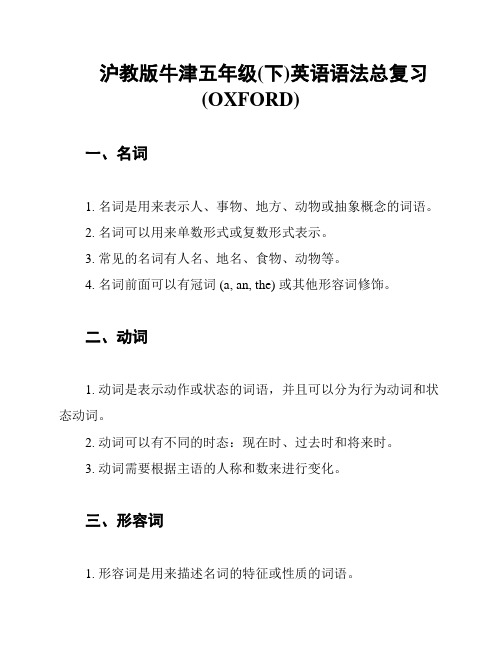
沪教版牛津五年级(下)英语语法总复习(OXFORD)一、名词1. 名词是用来表示人、事物、地方、动物或抽象概念的词语。
2. 名词可以用来单数形式或复数形式表示。
3. 常见的名词有人名、地名、食物、动物等。
4. 名词前面可以有冠词 (a, an, the) 或其他形容词修饰。
二、动词1. 动词是表示动作或状态的词语,并且可以分为行为动词和状态动词。
2. 动词可以有不同的时态:现在时、过去时和将来时。
3. 动词需要根据主语的人称和数来进行变化。
三、形容词1. 形容词是用来描述名词的特征或性质的词语。
2. 形容词通常用来修饰名词,用来给名词添加更多的信息。
3. 形容词在句子中通常位于名词之前。
四、副词1. 副词是用来修饰动词、形容词、副词或整个句子的词语。
2. 副词可以表示时间、地点、方式等不同的意义。
3. 副词一般位于动词或形容词之后,句子中的其他位置也可能出现。
五、代词1. 代词是用来代替名词或其他代词的词语。
2. 代词可以用来指代特定的人或事物,以避免重复使用名词。
3. 常见的代词有人称代词、物主代词和指示代词。
六、介词1. 介词是用来连接名词或代词与其他词语的词语。
2. 介词通常用来表示时间、地点、方式等不同的关系。
3. 常见的介词有 in, on, at, with, from, to 等。
七、连词1. 连词是用来连接词语、短语或句子的词语。
2. 连词可以用来连接并列的词语或句子,以及引导复合句等。
3. 常见的连词有 and, but, or, because, if, when 等。
八、冠词1. 冠词是用来限定名词的词语。
2. 冠词分为不定冠词 (a, an) 和定冠词 (the)。
3. 不定冠词用来表示泛指的意义,而定冠词用来表示特指的意义。
九、句子1. 句子是由单词和词组组成的表达完整意思的语言单位。
2. 句子可以分为陈述句、疑问句、祈使句和感叹句等不同类型。
3. 句子由主语和谓语构成,可以包含其他成分如宾语、定语、状语等。
小学牛津英语语法大全精心整理版
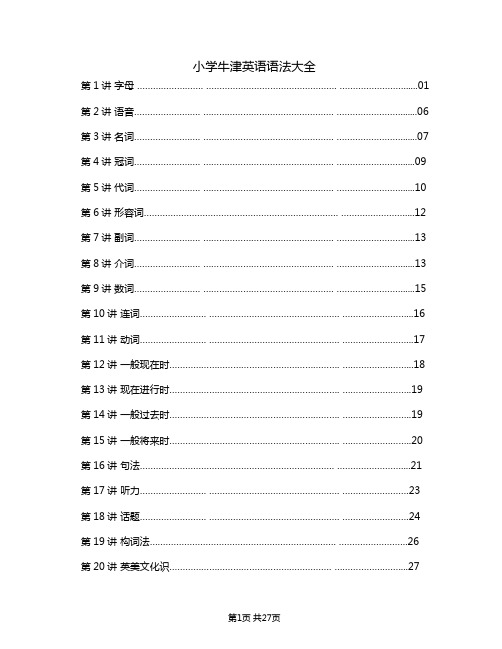
小学牛津英语语法大全第1讲字母......................... ................................................. (01)第2讲语音......................... ................................................. . (06)第3讲名词......................... ................................................. . (07)第4讲冠词......................... ................................................. (09)第5讲代词......................... ................................................. (10)第6讲形容词......................................................................... . (12)第7讲副词......................... ................................................. (13)第8讲介词......................... ................................................. (13)第9讲数词......................... ................................................. (15)第10讲连词......................... ................................................. (16)第11讲动词......................... ................................................. (17)第12讲一般现在时................................................................ (18)第13讲现在进行时................................................................ .. (19)第14讲一般过去时................................................................ .. (19)第15讲一般将来时................................................................ .. (20)第16讲句法......................................................................... . (21)第17讲听力......................... ................................................. . (23)第18讲话题......................... ................................................. . (24)第19讲构词法...................................................................... .. (26)第20讲英美文化识............................................................. . (27)第1讲字母1. 英语中共有26个字母。
(完整)上海版牛津英语六年级(上、下)全重点知识点复习整理,推荐文档
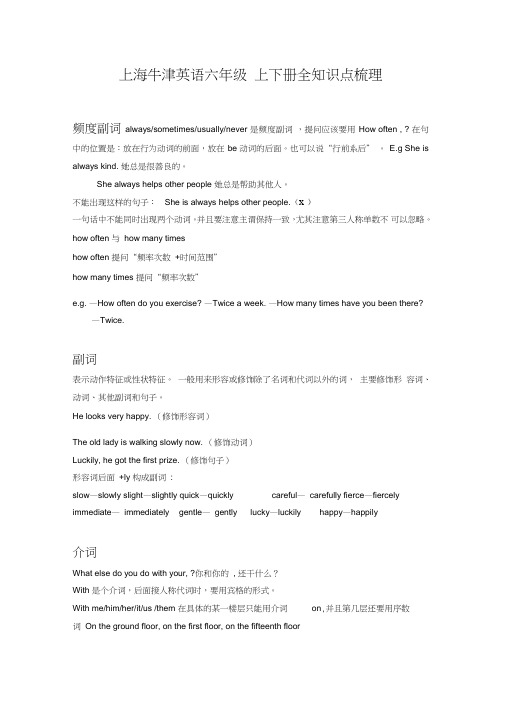
上海牛津英语六年级上下册全知识点梳理频度副词always/sometimes/usually/never 是频度副词,提问应该要用How often , ? 在句中的位置是:放在行为动词的前面,放在be 动词的后面。
也可以说“行前系后” 。
E.g She is always kind. 她总是很善良的。
She always helps other people 她总是帮助其他人。
不能出现这样的句子:She is always helps other people.(x )一句话中不能同时出现两个动词。
并且要注意主谓保持一致,尤其注意第三人称单数不可以忽略。
how often 与how many timeshow often 提问“频率次数+时间范围”how many times 提问“频率次数”e.g. —How often do you exercise? —Twice a week. —How many times have you been there?—Twice.副词表示动作特征或性状特征。
一般用来形容或修饰除了名词和代词以外的词,主要修饰形容词、动词、其他副词和句子。
He looks very happy. (修饰形容词)The old lady is walking slowly now. (修饰动词)Luckily, he got the first prize. (修饰句子)形容词后面+ly 构成副词:slow—slowly slight—slightly quick—quickly careful—carefully fierce—fiercely immediate—immediately gentle—gently lucky—luckily happy—happily介词What else do you do with your, ?你和你的, 还干什么?With 是个介词,后面接人称代词时,要用宾格的形式。
上海小学牛津英语语法归纳总结
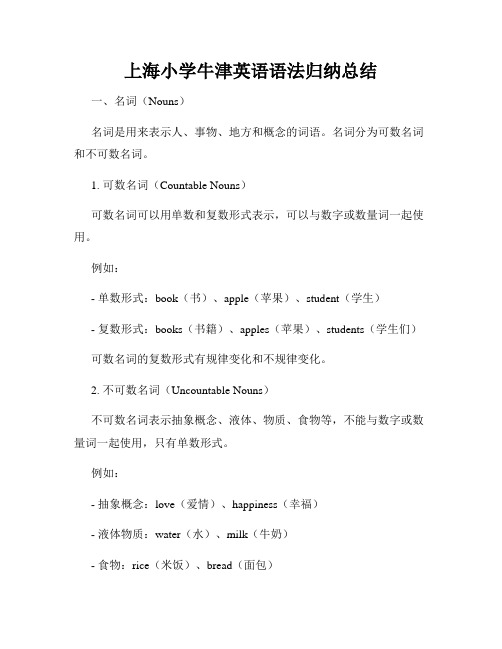
上海小学牛津英语语法归纳总结一、名词(Nouns)名词是用来表示人、事物、地方和概念的词语。
名词分为可数名词和不可数名词。
1. 可数名词(Countable Nouns)可数名词可以用单数和复数形式表示,可以与数字或数量词一起使用。
例如:- 单数形式:book(书)、apple(苹果)、student(学生)- 复数形式:books(书籍)、apples(苹果)、students(学生们)可数名词的复数形式有规律变化和不规律变化。
2. 不可数名词(Uncountable Nouns)不可数名词表示抽象概念、液体、物质、食物等,不能与数字或数量词一起使用,只有单数形式。
例如:- 抽象概念:love(爱情)、happiness(幸福)- 液体物质:water(水)、milk(牛奶)- 食物:rice(米饭)、bread(面包)不可数名词没有复数形式,不能直接与冠词a/an连用。
二、冠词(Articles)冠词用于限定名词的范围,分为定冠词和不定冠词。
1. 定冠词(Definite Article)定冠词是"the",用于特指已经提到的人或物,或者特指上下文中的某人或某物。
例如:- I saw a cat in the tree.(我看到树上有一只猫)- The cat was black.(那只猫是黑色的)2. 不定冠词(Indefinite Article)不定冠词有两种,分别是"a"和"an"。
用于泛指某一类人或物。
例如:- I have a dog.(我有一只狗)- She is an actress.(她是一名女演员)不定冠词"a"后面接辅音音素开头的词,"an"后面接元音音素开头的词。
三、形容词(Adjectives)形容词用来描述名词的特征和性质。
形容词通常位于名词之前。
- a big house(一个大房子)- a beautiful flower(一朵美丽的花)形容词可以用于比较级和最高级。
(word完整版)上海牛津英语5B语法知识点复习,推荐文档
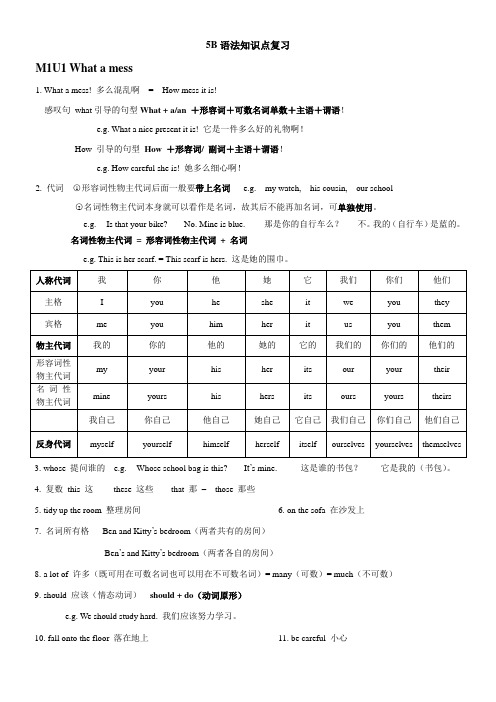
5B语法知识点复习M1U1 What a mess1. What a mess! 多么混乱啊= How mess it is!感叹句what引导的句型What + a/an +形容词+可数名词单数+主语+谓语!e.g. What a nice present it is! 它是一件多么好的礼物啊!How 引导的句型How +形容词/ 副词+主语+谓语!e.g. How careful she is! 她多么细心啊!2. 代词○1形容词性物主代词后面一般要带上名词 e.g. my watch, his cousin, our school○2名词性物主代词本身就可以看作是名词,故其后不能再加名词,可单独使用。
e.g. -- Is that your bike? -- No. Mine is blue. -- 那是你的自行车么?-- 不。
我的(自行车)是蓝的。
名词性物主代词= 形容词性物主代词+ 名词e.g. This is her scarf. = This scarf is hers. 这是她的围巾。
3. whose 提问谁的 e.g. -- Whose school bag is this? -- I t’s mine. -- 这是谁的书包?-- 它是我的(书包)。
4. 复数this 这- these 这些that 那–those 那些5. tidy up the room 整理房间6. on the sofa 在沙发上7. 名词所有格Ben and Kitty’s bedroom(两者共有的房间)Ben’s and Kitty’s bedroom(两者各自的房间)8. a lot of 许多(既可用在可数名词也可以用在不可数名词)= many(可数)= much(不可数)9. should 应该(情态动词)should + do(动词原形)e.g. We should study hard. 我们应该努力学习。
- 1、下载文档前请自行甄别文档内容的完整性,平台不提供额外的编辑、内容补充、找答案等附加服务。
- 2、"仅部分预览"的文档,不可在线预览部分如存在完整性等问题,可反馈申请退款(可完整预览的文档不适用该条件!)。
- 3、如文档侵犯您的权益,请联系客服反馈,我们会尽快为您处理(人工客服工作时间:9:00-18:30)。
上海牛津小学英语语法知识总结精选文档 TTMS system office room 【TTMS16H-TTMS2A-TTMS8Q8-上海牛津小学英语语法知识总结一般现在时1、定义:表示经常发生或习惯性的动作、状态。
句中通常有usually,often,every day,sometimes,always,at weekends,on Sundays等表示经常性时间的短语。
2、构成:1)当谓语是be动词时,一般现在时的构成:主语+be动词+其他如:I am a student.He is Jim’s father.They are from Japan.2)当谓语是行为动词时,一般现在时的构成:①主语(非第三人称单数)+动词原形+其他如:I often watch TV at the weekends.Mr Green and Mrs Green like collecting stamps.②主语(第三人称单数)+动词的第三人称单数形式+其他如:Jim usually visits his grandparents on Sundays.She sometimes goes to the park with her mother.3、动词三单形式的变化规则:•一般情况下,直接加s 如:read-reads,swim-swims•以s,x,sh,ch,o结尾,加es•如:wash-washes,watch-watches,do-does••以辅音字母+y结尾,变y为i,再加es•如:study-studies,fly-flies••不规则变化如:have-has•4、一般现在时的句型转换:肯定句否定句一般疑问句及回答They watch TV every day. They don’t watch TVevery day.—Do they watch TV every day?—Yes, they do. / No, they don’t.She watches TV every day. She doesn’twatchTV every day.—Does she watch TV every day?—Yes, she does. / No, she doesn’t.现在进行时1、定义:表示现在或现阶段正在进行或发生的动作。
句中常有now,look,listen等词。
如:I am washing clothes now.Look! Liu Tao is climbing the tree.Listen! Jane is singing in the music room.2、构成:be动词(am/is/are)+ 动词现在分词(V-ing)3、动词现在分词构成:•一般是在动词原形后加ing如:read-reading,drink-drinking,eat-eating,look-looking•以不发音的e结尾的动词,去掉e,再加ing如:write-writing,make-making,ride-riding,take-taking•以重读闭音节结尾,如末尾只有一个辅音字母,要双写这个字母,再加ing 如:sit-sitting,swim-swimming,put-putting,run-running,stop-stopping,get-getting,begin-beginning,jog-jogging,forget-forgetting4、动名词其实就是动词的现在分词,它既有名词性质(可作主语),又有动词性质(可带宾语)。
如:Asking the wayMy hobby is collecting stamps.He is good at skating.5、现在进行时的句型转换:肯定句否定句一般疑问句及回答He is running now. He isn’t running now. —Is he running now? —Yes, he is. / No, he isn’t.They are making a puppet. They aren’t makinga puppet.—Are they making a puppet?—Yes, they are. / No, theyaren’t.一般过去时1、定义:表示过去某个时间里发生的动作或存在的状态。
常和表示过去的时间状语连用,如:a moment ago,just now,yesterday,last week,this morning等。
如:My brother often went to school by bike last term.The watch was beside the diary a moment ago.I watched the moon and ate the moon cakes last Mid-Autumn Festival.Jim went to the supermarket yesterday.2、构成:主语+动词的过去式+其他3、动词过去式的变化规则:•一般在动词原形末尾加ed 如:play-played,listen-listened,look-looked •结尾是e的动词,加d 如:live-lived,like-liked,taste-tasted•辅音字母+y结尾的动词,变y为i,再加ed 如:study-studied,carry-carried,cry-cried••末尾只有一个辅音字母的重读闭音节词,双写这个辅音字母,再加ed 如:stop-stopped,plan-planned••不规则变化如:am/is-was are-were have/has-had do-didgo-went sit-sat tell-told see-sawget-got make-made give-gave read-readbuy-bought come-came draw-drew eat-ate fly-flew meet-met put-put run-ran say-said sing-sang swim-swam take-took 4、一般过去时的句型转换肯定句否定句一般疑问句及回答He watched TV yesterday. He didn’t watch TVyesterday.—Did he watch TV yesterday?—Yes, he did. / No, he didn’t.They played games just now. They didn’t play gamesjust now.—Did they play games just now?—Yes, they did. / No, they didn’t.一般将来时1、定义:表示将要发生的动作或存在的状态,以及打算、计划或准备某事。
句中一般含有表示将来的时间状语,如:tomorrow morning,next week,this afternoon等表示将来的时间状语。
2、构成:①be gong to +动词原形如:I am going to see a Beijing opera tomorrow.We are going to meet at bus stop at half past ten.Dad and I are going to see a Beijing opera this afternoon.②will +动词原形如:They will go swimming this afternoon.3、be going to 和will 区别:① be going to表示经过事先安排、打算或决定要做的事情,基本上一定会发生;will则表示有可能去做,但不一定发生,也常表示说话人的临时决定。
如:I am going to take part in a party this evening.They are cleaning the library now. I’ll go and join them.②be going to表示近期或眼下就要发生的事情;will表示的将来时间则较远一些。
如:He is going to write a letter tomorrow.I will meet her one day.③ be going to还可以用来表示有迹象表明某件事将要发生,常用于天气等自然现象。
如:Look! It’s going to rain.4、一般将来时句型转换:肯定句否定句一般疑问句及回答She is going to have a picnic tomorrow. She isn’t going to have a picnic tomorrow. —Is she going to have apicnic tomorrow? —Yes, she is . / No, sheisn’t .They will go swimming this afternoon. They will not(won’t) go swimming this afternoon. —Will they go swimmingthis afternoon? —Yes, they will . / No, theywon’t .句法1、陈述句说明事实或陈述说话人观点的句子。
基本结构:主语+谓语+其他 1)肯定陈述句 We all like pandas very much.2)否定陈述句 He doesn’t do housework at weekends3)肯定陈述句改否定陈述句①一般是在be 动词或情态动词后加not 。
Mary was at school yesterday. —> Mary was not at school yesterday. I can make a model plane. —>I can not make a model plane.②不含be 动词或情态动词的,行为动词前要用助动词的否定式(don’t ,doesn’t ,didn’t ),后面跟动词的原形。
He likes drawing pictures.—>He doesn’t like drawing pictures.I went to the park yesterday. —>I didn’t go to the park yesterday.4)陈述句改一般疑问句①有be 动词或情态动词的,把be 动词或情态动词提前。
